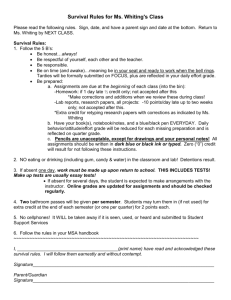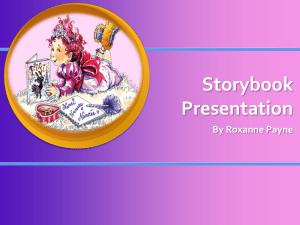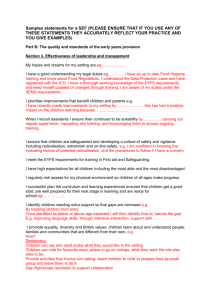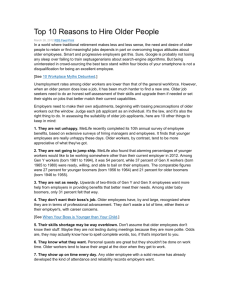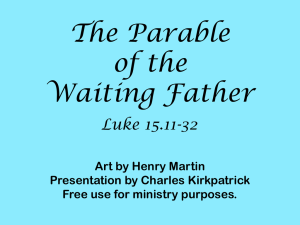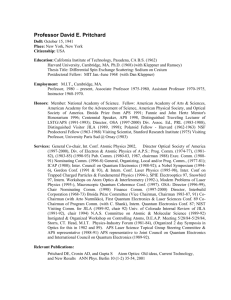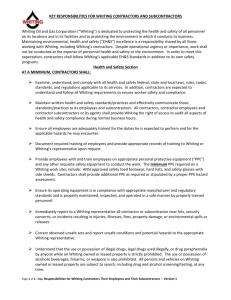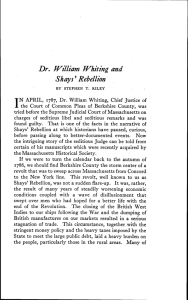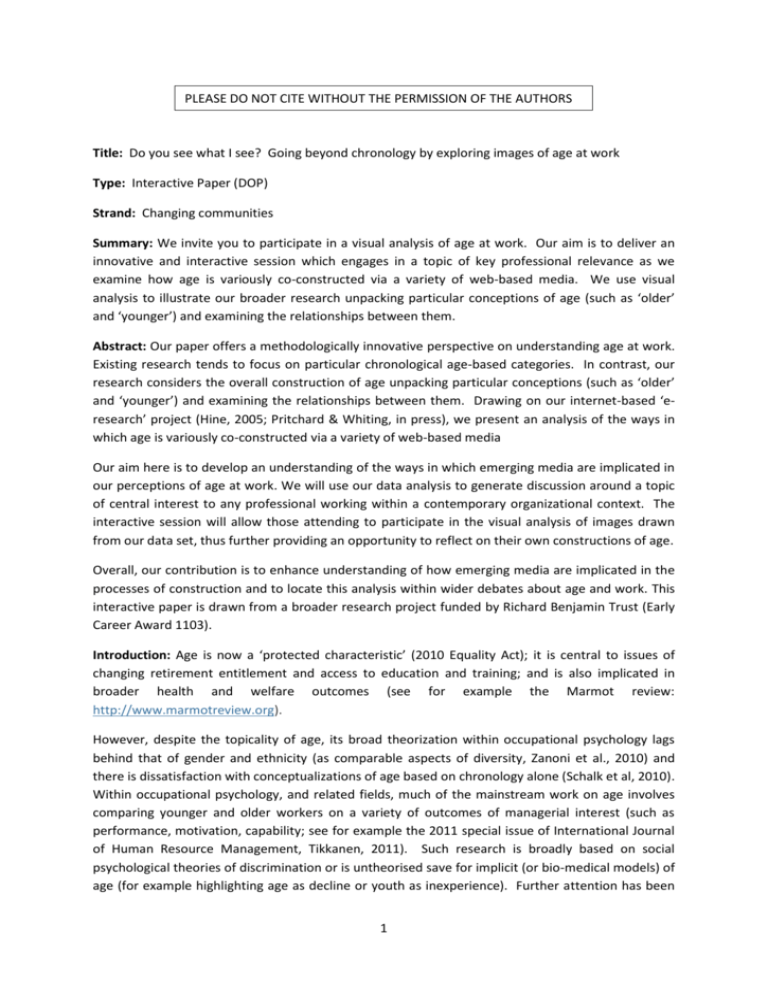
PLEASE DO NOT CITE WITHOUT THE PERMISSION OF THE AUTHORS
Title: Do you see what I see? Going beyond chronology by exploring images of age at work
Type: Interactive Paper (DOP)
Strand: Changing communities
Summary: We invite you to participate in a visual analysis of age at work. Our aim is to deliver an
innovative and interactive session which engages in a topic of key professional relevance as we
examine how age is variously co-constructed via a variety of web-based media. We use visual
analysis to illustrate our broader research unpacking particular conceptions of age (such as ‘older’
and ‘younger’) and examining the relationships between them.
Abstract: Our paper offers a methodologically innovative perspective on understanding age at work.
Existing research tends to focus on particular chronological age-based categories. In contrast, our
research considers the overall construction of age unpacking particular conceptions (such as ‘older’
and ‘younger’) and examining the relationships between them. Drawing on our internet-based ‘eresearch’ project (Hine, 2005; Pritchard & Whiting, in press), we present an analysis of the ways in
which age is variously co-constructed via a variety of web-based media
Our aim here is to develop an understanding of the ways in which emerging media are implicated in
our perceptions of age at work. We will use our data analysis to generate discussion around a topic
of central interest to any professional working within a contemporary organizational context. The
interactive session will allow those attending to participate in the visual analysis of images drawn
from our data set, thus further providing an opportunity to reflect on their own constructions of age.
Overall, our contribution is to enhance understanding of how emerging media are implicated in the
processes of construction and to locate this analysis within wider debates about age and work. This
interactive paper is drawn from a broader research project funded by Richard Benjamin Trust (Early
Career Award 1103).
Introduction: Age is now a ‘protected characteristic’ (2010 Equality Act); it is central to issues of
changing retirement entitlement and access to education and training; and is also implicated in
broader health and welfare outcomes (see for example the Marmot review:
http://www.marmotreview.org).
However, despite the topicality of age, its broad theorization within occupational psychology lags
behind that of gender and ethnicity (as comparable aspects of diversity, Zanoni et al., 2010) and
there is dissatisfaction with conceptualizations of age based on chronology alone (Schalk et al, 2010).
Within occupational psychology, and related fields, much of the mainstream work on age involves
comparing younger and older workers on a variety of outcomes of managerial interest (such as
performance, motivation, capability; see for example the 2011 special issue of International Journal
of Human Resource Management, Tikkanen, 2011). Such research is broadly based on social
psychological theories of discrimination or is untheorised save for implicit (or bio-medical models) of
age (for example highlighting age as decline or youth as inexperience). Further attention has been
1
given to measuring (usually via large scale cross sectional surveys) the impact of ageism and/or age
diversity in the workplace on both individual and organizational outcomes (Kunze et al., 2011; Snape
& Redman, 2003).
This research project is founded on the proposition that we need new and richer conceptualisations
of age that move away from the notions of age as chronology and as an individual attribute.
Methodology and Analysis: It has been suggested that many aspects of work and working life are in
part constructed through and by ‘media spectacle’ (Tan, 2011: 169). Such perspectives make it both
possible and desirable to examine the concept of age in the workplace without locating the research
participants within a ‘traditional’ organizational context. In addition to our inclusive approach to
conceptualising age, this method also allows us to consider various constructions of work, including
employment, unemployment and underemployment. These notions are all central to popular
discourses that reference age related issues. Our e-research approach utilises a variety of tools (e.g.
Nexis, Google Alerts and Twilerts) to identify a range of web-based data (blogs, twitter, websites)
thus enabling consideration of a wide range of representations of age at work. We have gathered
images, stories, accounts and discussions about age at work published on the internet, for example
via on-line news media and blogs. Data vary in size from 140 character ‘tweets’ to interactive online
discussions running to 20 pages of downloaded text. Audio, image and video data were also
collected. Following an initial pilot (Pritchard and Whiting, In press), data collection proceeded via
daily ‘sweeps’ of (English language material) on the worldwide web over a five month period,
producing over 800 items of ‘composite data’ and nearly 8000 tweets. The project followed
recognised ethical guidelines with respect to e-research (BPS, 2007; ESS 2009) acknowledging that
these are ongoing and emerging debates particularly with respect to definitions of public and private
data. Accordingly, only public data have been collected. With respect to the images presented
within the session, we are utilising these under the principles of ‘fairdealing’ (as defined under the
1988 Copyright Designs and Patents Act, UK), printed copies of the images will not be provided and
all source and credit information is provided. The focus of the analysis presented in this session
draws on a sample of 120 images collected during the above research process. Drawing on Rose
(2001) and Davison (2010) we treat these images as ‘portraits’ and will invite participants to reflect
on the relationship between the images and their broader textual context. Specifically, we plan to
unpack five images associated with the following headlines:
Gen Y vs. Boomers: workplace conflict heats up
Generation betrayed by bogus promises: our failing schools are ‘forcing UK firms to choose
foreign workers’
Age discrimination ‘rooted’ in society Government finds
Older workers struggle to retain position in the workforce
Record fall in employed over-65s shows businesses rushed to retire workers
Further analytically we unpack the visual image through analysis of poses, props, dress and
appearance. The interactive aspect of the session will allow those attending to participate in the
analytic process. We will further present our own analysis, highlighting the ‘agential cuts’ (Barad
2003) within the images that lead us to ‘see’ and ‘understand’ representations of particular binary
combinations (for example older man, younger women) while also unpacking the processes of
‘foregrounding’ and ‘backgrounding’ within the constructions of relationships between age and
employability.
2
Interactive Design of the session: The focus during this interactive paper session is to allow those
attending to participate in the visual analysis of images drawn from our data set. Participants will
be shown a variety of images and provided with the associated headlines. Participants will then be
asked to suggest which headline they would place with each image, leading to a discussion of the
relationships between the text and the image in their original web context. Specific approaches to
visual analysis will be explained and participants encouraged to consider the sample images in ways
that unpack how these depict (or challenge) popular conceptions of our understandings of age at
work. We anticipate that at least one third of the session will be interactive.
What might the public find interesting about your research? Even a brief look at the popular press
indicates the continuing prominence of debates regarding the rights and challenges of both ‘older’
and ‘younger’ workers. For example, retirement is being redefined for ‘older’ workers, while at the
same time access to university education is being re-positioned as an individual investment for the
‘younger’ generation. Further, generational tensions emerge as these categories are constructed as
mutually exclusive or in competition with each other in the labour market. Therefore reviewing and
encouraging a critical analysis of representations of age is both topical and an important alternative
contribution to current debates.
What is new and different about your research? This research is both conceptually and
methodologically innovative. It is conceptually innovative in its approach to unpacking the
construction of age at work and in its approach to considering our understandings of both ‘younger’
and ‘older’ as entangled. It is methodologically innovative in its underpinning e-research approach,
and as presented here, in engaging the audience in visual analysis.
Conclusions: Our aim is to deliver an innovative and interactive session which engages in a topic of
key professional relevance as we examine how age is variously co-constructed via a variety of webbased media.
References:
Barad, K. (2003) Posthumanist performativity: Toward an understanding of how matter comes to
matter. Signs, 28 (3): 801-831
BPS (2007) Report of the Working Party on conducting research on the Internet: Guidelines for
ethical practice in psychological research online. Leicester, British Psychological Society
Davison, J. (2010). [In]visible [in]tangibles: Visual portraits of the business élite. Accounting,
Organizations and Society, 35(2), 165-183
Ess, C. (2009) Digital Media Ethics, Cambridge: Polity Press.
Hine, C. (2005) Internet Research and the sociology of cyber-social-scientific knowledge. The
Information Society 21: 239-248.
Kunze, F., Boehm, S. A., & Bruch, H. (2011). Age diversity, age discrimination climate and
performance consequences - a cross organizational study. Journal of Organizational Behavior, 32(2):
264-290.
3
Pritchard, K and Whiting, R (2012) ‘Autopilot? A reflexive review of the piloting process in
qualitative e-research’ Qualitative Research in Organizations and Management (In Press)
Rose (2001) Visual Methodologies. London: Sage
Schalk, R., van Veldhoven, M., de Lange, A. H., De Witte, H., Kraus, K., & Stamov-Rossnagel, C.
(2010). Moving European research on work and ageing forward: Overview and agenda. European
Journal of Work and Organizational Psychology, 19(1): 76-101.
Snape, E., & Redman, T. (2003). Too old or too young? The perceived impacts of age discrimination.
Human Resource Management Journal, 13(1): 78-89.
Tan, S. (2011), "Facts, opinions and media: spectacle: exploring representations of business news on
the internet", Discourse & Communication, 5( 2): 169-194.
Tikkanen, T (2011). From managing a problem to capitalizing on talent and experience of older
workers. The International Journal of Human Resource Management, 22(6): 1217-1220.
Zanoni, P., Janssens, M., Benschop, Y., & Nkomo, S. (2010). Unpacking diversity, grasping inequality:
Rethinking difference through critical perspectives. Organization, 17(1): 9-29.
Authors: Dr Katrina Pritchard (k.pritchard@bbk.ac.uk) and Dr Rebecca Whiting
Place of work: Department of Organizational Psychology, Birkbeck, University of London
©Copyright Katrina Pritchard and Rebecca Whiting. All rights reserved.
4

